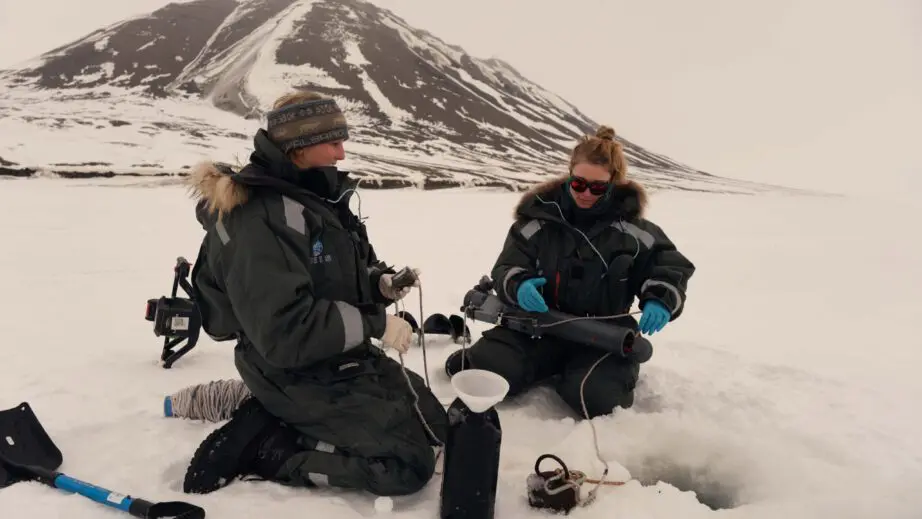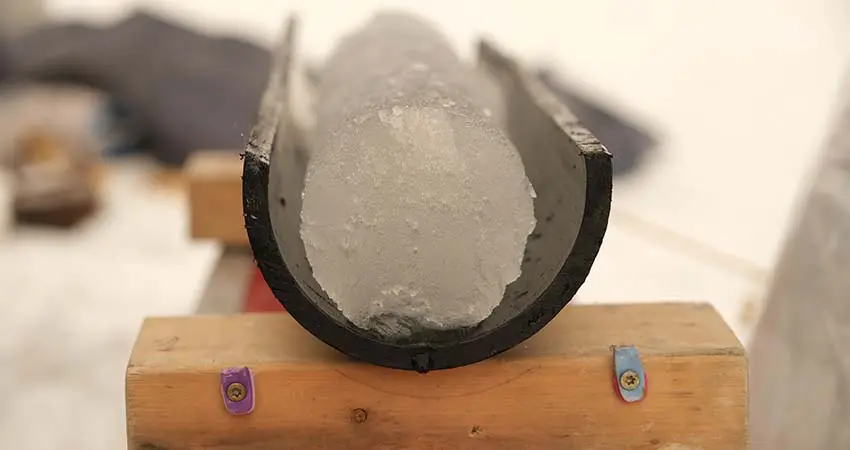Hidden biodiversity inside of Svalbard’s sea ice

Rebecca Duncan and Vanessa Pitusi doing fieldwork on Van Mijenfjorden. Photo: Maria Philippa Rossi/UNIS
Top image: Rebecca Duncan and Vanessa Pitusi doing fieldwork on Van Mijenfjorden. Photo: Maria Philippa Rossi/UNIS
22 May 2021
Text: Rebecca Duncan and Vanessa Pitusi, PhD Candidates UNIS Svalbard
What do you see when you look at the sea ice? A vast extent of seemingly white nothingness, maybe dotted with a few cute seals soaking up the sunshine or a polar bear on the prowl. Would you believe that just below the surface is a hustling and bustling ecosystem?
Right where the ice finishes and the ocean begin is a community dominated by microscopic plants and animals (known as ice algae and meiofauna), thriving despite the harsh conditions; low light, high salinity and very cold temperatures. The bottom of the ice layer is a labyrinth of small (< 1 mm) channels which allow the ice algae to flourish, providing an all-you-can-eat buffet for the meiofauna.

Big players in the Arctic marine ecosystem
As small as these plants and animals may be, they are big players in the Arctic marine ecosystem. Polar food webs are short, and small changes at the production level have cascading effects on higher trophic levels. As the base of the food web and an energy powerhouse for the polar marine system, alterations to the nutritional content of the ice algae are experienced through the entire food chain.
For example, polar bears, the notorious king of the Arctic marine food web, have been found to have over 70% of their marine-derived lipids and fatty acids obtained indirectly from ice algae. So even the largest marine mammals feel the effects of the smallest changes to the microscopic ice community.
It is this potential for algal-driven ecosystem change which has fascinated Rebecca Duncan, PhD candidate with University Technology Sydney and UNIS Svalbard. This year, she has been investigating how the ice algae are likely to change their protein and lipid content with climate-induced changes to sea ice thickness and snow cover, and how such changes may be expected to carry through and affect the broader marine food web.
Critter kindergarten
The direct consumers of the ice algae, the meiofauna, are a collection of small critters with other-worldly appearances. They are generally the babies of species found in the water below the ice or on the sea floor. The ice acts as a refuge and nursery ground where they can find protection from predators and plenty of food to aid their growth and development. As such, changing sea ice conditions might potentially become challenging for these “kindergarteners”.
Very little is known about the ice meiofauna, which is why Vanessa Pitusi, PhD candidate with UNIS Svalbard and the University in Tromsø, is on a mission to determine who is present in the community, to better understand their role in the ecosystem and to foretell the potential consequences of changing sea ice conditions.

To investigate this diverse ice community and answer these timely questions, the UNIS sea ice biology team have been driving via snowmobile to different ice-covered fjords on Spitsbergen, throughout the productive months of April and May. At each site, they take a number of ice cores and a suite of physical measurements, allowing them to track the development of the spring bloom of life under the ice.
So next time you’re travelling on the sea ice, don’t forget to stop and think of the diverse ecosystem right beneath your feet!
Learn more
If you want to find more or learn about the collaboration with the Hearts in the Ice ladies (first women team to overwinter in the Arctic), watch this video.
And check out this article by Pitusi et al. (2021) – The occurrence of Nematoda in coastal sea ice on Svalbard (European Arctic) determined with the 18S small subunit rRNA gene.